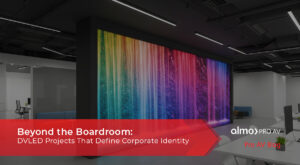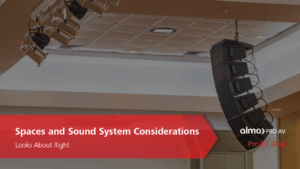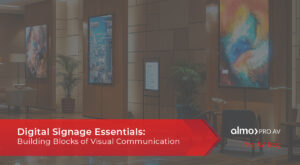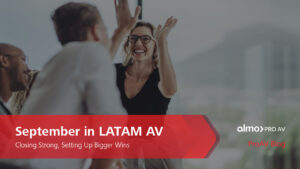Why Is Quality Important When Selecting Audio?
I was pondering this topic recently when I met a friend for lunch at one of my favorite eatery places. They recently moved to a new location and ever since moving, it’s been difficult to really enjoy eating at the place. My friend and I were discussing how incredibly loud the place gets, to the point that it’s difficult to really have a conversation with each other. As a result, I often just pick up the food and bring it home. This situation really made me wonder what was missing in the audio design when they moved to this new location. I decided to do some research by talking to our Exertis Almo Audio Experts to gain some insight and, hopefully, help you avoid this common mistake.
When choosing the audio technology for a project, every installation is a reflection of your brand and reputation. Customers expect their audio systems to perform without trouble, and it’s essential to select quality solutions that deliver exceptional functionality and reliability. Fortunately, there are many high-quality audio options with cost-conscious price tags, so you won’t have to compromise on excellence.
Additionally, quality is often reflected in the ease of installation. Specifically in meeting rooms, huddle spaces, and classrooms, audio technology should be simple to use and strive to avoid any frustration for the end-user. This simplicity can help ensure that the technology is used effectively, avoiding the common pitfall of equipment going unused due to user confusion.
Here are a few key considerations when selecting quality audio technology.
Assess your environment.
 Before installing audio equipment, it’s important to evaluate the space itself, as there are many factors that affect audio quality. It’s essential to consider the acoustics of an environment, as a particular space might require a few changes to adjust the echo and create a more comfortable listening experience once the audio equipment is installed.
Before installing audio equipment, it’s important to evaluate the space itself, as there are many factors that affect audio quality. It’s essential to consider the acoustics of an environment, as a particular space might require a few changes to adjust the echo and create a more comfortable listening experience once the audio equipment is installed.
In fact, it’s common to run into acoustical issues in multi-use spaces, as they’re designed with several functions in mind. For example, a school might utilize a single space for their gym and auditorium, which can cause acoustical design to be overlooked. In essence, you’ll want to assess an environment before investing in any audio technology, as acoustical treatment is an essential step in providing a high-quality audio experience.
Consider service and warranty.
Along with functionality and reliability, quality often correlates with the level and service and warranty provided by manufacturers. Although you aim to avoid any issues with a particular product, you should ensure that support is readily available if problems arise with a manufacturer’s technology. This aspect of product selection is frequently overlooked, but having a product warranty and readily available support can help save time and protect your reputation with your customers.
 See the products in action.
See the products in action.
When you get to experience the way in which products function across various environments, you can understand the practical applications of those solutions. There are a variety of educational resources available to strengthen your understanding of a product, and you can later apply that knowledge in the field to truly understand how the technology functions in a particular space.
Don’t overlook the audio.
If you’re looking to achieve high-quality audio in a space, it’s essential to ensure that the audio is not overlooked in the planning and design process. Oftentimes, the visual aspects receive far more attention, like displays and protection technology. In order to design a well-rounded, comfortable space for users, the audio and visual components must both be at the top of the list.
The bottom line is that quality audio is paramount for successful, comfortable communication.
For me, the main takeaway was simply that it’s crucial to assess the environment, because, in my scenario, the restaurant would have identified ways to absorb the noise. Would that have fixed it completely? It would make it more comfortable for their patrons to chat, and they’d potentially spend more time and money. It might’ve cost a few more dollars, which would have paid off in the long run.
You always have available resources to assist with all of your audio and video needs at Exertis Almo. Please feel free to contact me or your Exertis Almo team.

Angie Greene | DSCE
Business Development Manager
Supported Manufacturers: Panasonic Connect

 Want to know something? Ask someone who has been around a while. An example of this was back in 2007 as I got off the train in Guilford in Surrey, England. I needed directions to my hotel and since the information center was closed, I made inquiry with the nearest group of locals. They were younger and had never heard of the place. Their knowledge was limited. Afterwards I sought assistance from a much older person that I saw. Instant useable information. He knew his small town and how to get around.
Want to know something? Ask someone who has been around a while. An example of this was back in 2007 as I got off the train in Guilford in Surrey, England. I needed directions to my hotel and since the information center was closed, I made inquiry with the nearest group of locals. They were younger and had never heard of the place. Their knowledge was limited. Afterwards I sought assistance from a much older person that I saw. Instant useable information. He knew his small town and how to get around. In this case, what I discovered was a person with much the same in product preferences and a similar approach in design philosophy. It was very beneficial, when either of us got a project, to get on a Zoom call to discuss, assess and quickly arrive at an effective design approach. Yes, the client may have been inquiring about a product or solution they’d seen but we could also look beyond at what problem they might be trying to address with that equipment or inquiry. It helped us to better get to a real solution rather than just coming up with a list of boxes that could be sold. There’s a lot of value in that and it comes only with experience.
In this case, what I discovered was a person with much the same in product preferences and a similar approach in design philosophy. It was very beneficial, when either of us got a project, to get on a Zoom call to discuss, assess and quickly arrive at an effective design approach. Yes, the client may have been inquiring about a product or solution they’d seen but we could also look beyond at what problem they might be trying to address with that equipment or inquiry. It helped us to better get to a real solution rather than just coming up with a list of boxes that could be sold. There’s a lot of value in that and it comes only with experience. Truthfully, you need the best of both youth and maturity if you’re not going to be left with a warehouse of FireWire interfaces or trying to sell solutions that promise to change everything but in practice, have limited application.
Truthfully, you need the best of both youth and maturity if you’re not going to be left with a warehouse of FireWire interfaces or trying to sell solutions that promise to change everything but in practice, have limited application.
 Crystal-Clear Communication
Crystal-Clear Communication Who said training has to be boring? With the latest interactive displays, training sessions become an immersive experience that gets everyone pumped. Picture this: government employees in front of massive touchscreens, collaborating on real-time scenarios, and solving problems together like a band jamming out a new hit.
Who said training has to be boring? With the latest interactive displays, training sessions become an immersive experience that gets everyone pumped. Picture this: government employees in front of massive touchscreens, collaborating on real-time scenarios, and solving problems together like a band jamming out a new hit.  Now, let’s crank it up a notch for our audience with hearing impairments. Assisted listening devices (ALDs) are like the VIP passes that make sure everyone gets front-row sound, no matter where they’re seated. One of the rockstars in this space is Listen Technologies with their Listen EVERYWHERE system. This cutting-edge solution streams audio directly to users’ smartphones, letting them tap into the sound with their own headphones or hearing aids. Whether it’s hearing loops that sync up with hearing aids or infrared systems that cut through the noise, these bad boys plug right into the AV setup, delivering crystal-clear audio straight to those who need it most.
Now, let’s crank it up a notch for our audience with hearing impairments. Assisted listening devices (ALDs) are like the VIP passes that make sure everyone gets front-row sound, no matter where they’re seated. One of the rockstars in this space is Listen Technologies with their Listen EVERYWHERE system. This cutting-edge solution streams audio directly to users’ smartphones, letting them tap into the sound with their own headphones or hearing aids. Whether it’s hearing loops that sync up with hearing aids or infrared systems that cut through the noise, these bad boys plug right into the AV setup, delivering crystal-clear audio straight to those who need it most.

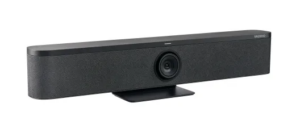 So, why all the buzz about the Vaddio Venture VideoBar? Picture this: you’ve got an important meeting, and you need everyone to be seen and heard perfectly, whether they are in the room or joining remotely. The Venture VideoBAR is designed to handle just that with style and ease.
So, why all the buzz about the Vaddio Venture VideoBar? Picture this: you’ve got an important meeting, and you need everyone to be seen and heard perfectly, whether they are in the room or joining remotely. The Venture VideoBAR is designed to handle just that with style and ease.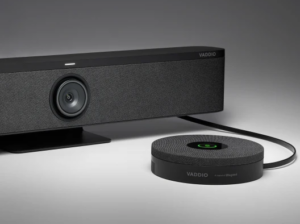 Another cool feature is the intelligent auto-framing. This smart tech automatically adjusts the camera to focus on whoever is speaking or the whole group, depending on what is happening. It’s like having a personal cameraman who never misses a beat. This means less fiddling with controls and more focus on the conversation.
Another cool feature is the intelligent auto-framing. This smart tech automatically adjusts the camera to focus on whoever is speaking or the whole group, depending on what is happening. It’s like having a personal cameraman who never misses a beat. This means less fiddling with controls and more focus on the conversation.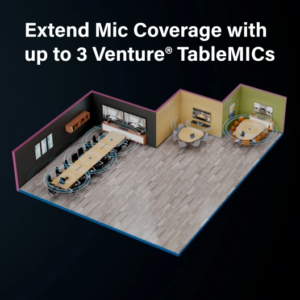 Classrooms and Training Rooms: Teachers and trainers will appreciate the clear visuals and sound, making it easier to engage students or trainees. It is a great tool for hybrid learning environments where you need to connect with people both in the room and online.
Classrooms and Training Rooms: Teachers and trainers will appreciate the clear visuals and sound, making it easier to engage students or trainees. It is a great tool for hybrid learning environments where you need to connect with people both in the room and online.
 First, what is TAA compliance?
First, what is TAA compliance? If you are looking to learn more, you can
If you are looking to learn more, you can  Moreover, a key component of TAA-compliance is the idea of substantial transformation, and navigating TAA-compliance comes with challenges. Manufacturers ensure compliance through third-party validation of their products, but complexities arise due to the varying interpretations of “substantial transformation” and the origin of components. This process depends on the product and tends to be quite subjective, as independent companies can validate whether there is enough of a difference between an incoming part and a final product.
Moreover, a key component of TAA-compliance is the idea of substantial transformation, and navigating TAA-compliance comes with challenges. Manufacturers ensure compliance through third-party validation of their products, but complexities arise due to the varying interpretations of “substantial transformation” and the origin of components. This process depends on the product and tends to be quite subjective, as independent companies can validate whether there is enough of a difference between an incoming part and a final product.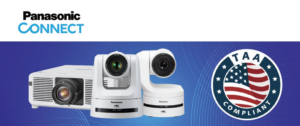
 A survey that I saw about workplaces taken pre-pandemic showed that audio was four times more important than video and that 4 of the top 5 frustrations were related to audio. None of the top five were video related yet the majority of the investments were expected to be focused on displays and control systems. The blinky lights. Little “a”, big “V”.
A survey that I saw about workplaces taken pre-pandemic showed that audio was four times more important than video and that 4 of the top 5 frustrations were related to audio. None of the top five were video related yet the majority of the investments were expected to be focused on displays and control systems. The blinky lights. Little “a”, big “V”. The one thing that hasn’t changed over time is the human. Humans communicate with other humans using the same interfaces, the same eyes and ears they’ve been using since we were drawing pictures on cave walls.
The one thing that hasn’t changed over time is the human. Humans communicate with other humans using the same interfaces, the same eyes and ears they’ve been using since we were drawing pictures on cave walls. I’ve seen meeting rooms with tall open ceilings including exposed joists and ductwork – all the properties of a mini gymnasium. Another one was an open office concept in an old warehouse made of concrete with a conferencing set up in the middle of the open area. It had all the acoustical properties of a parking garage. I’ve been asked for a mix-minus system in a room that’s less than 1,100 sq. ft. because the acoustics are so bad. It had a very tall “V” shaped ceiling that rises on both ends and comes down to a point about 12 ft. AFF in the center of the room. But it has a skylight.
I’ve seen meeting rooms with tall open ceilings including exposed joists and ductwork – all the properties of a mini gymnasium. Another one was an open office concept in an old warehouse made of concrete with a conferencing set up in the middle of the open area. It had all the acoustical properties of a parking garage. I’ve been asked for a mix-minus system in a room that’s less than 1,100 sq. ft. because the acoustics are so bad. It had a very tall “V” shaped ceiling that rises on both ends and comes down to a point about 12 ft. AFF in the center of the room. But it has a skylight.


